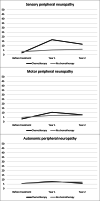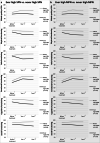The course of peripheral neuropathy and its association with health-related quality of life among colorectal cancer patients
- PMID: 33185839
- PMCID: PMC7966630
- DOI: 10.1007/s11764-020-00923-6
The course of peripheral neuropathy and its association with health-related quality of life among colorectal cancer patients
Abstract
Purpose: To gain more insight into the course of chemotherapy-induced peripheral neuropathy (CIPN) and its impact on health-related quality of life (HRQoL) in a population-based sample of colorectal cancer (CRC) patients up to 2 years after diagnosis.
Methods: All newly diagnosed CRC patients from four hospitals in the Netherlands were eligible for participation in an ongoing prospective cohort study. Patients (n = 340) completed questions on CIPN (EORTC QLQ-CIPN20) and HRQoL (EORTC QLQ-C30) before initial treatment (baseline) and 1 and 2 years after diagnosis.
Results: Among chemotherapy-treated patients (n = 105), a high sensory peripheral neuropathy (SPN) level was reported by 57% of patients at 1 year, and 47% at 2-year follow-up, whereas a high motor peripheral neuropathy (MPN) level was reported by 47% and 28%, at years 1 and 2, respectively. Linear mixed model analyses showed that SPN and MPN symptoms significantly increased from baseline to 1-year follow-up and did not return to baseline level after 2 years. Patients with a high SPN or MPN level reported a worse global quality of life and a worse physical, role, emotional, cognitive, and social functioning compared with those with a low SPN or MPN level.
Conclusions: Future studies should focus on understanding the mechanisms underlying CIPN so targeted interventions can be developed to reduce the impact of CIPN on patient's lives.
Implications for cancer survivors: Patients need to be informed of both CIPN and the impact on HRQoL.
Keywords: Colorectal cancer; Health-related quality of life; PROFILES; Peripheral neuropathy.
Conflict of interest statement
The authors declare that they have no conflict of interest.
Figures



References
-
- Nederlandse Kankerregistratie. Cijfers over Kanker. Available from: http://www.cijfersoverkanker.nl/. Accessed 12 Nov 2019.
-
- Hershman DL, Lacchetti C, Dworkin RH, Lavoie Smith EM, Bleeker J, Cavaletti G, Chauhan C, Gavin P, Lavino A, Lustberg MB, Paice J, Schneider B, Smith ML, Smith T, Terstriep S, Wagner-Johnston N, Bak K, Loprinzi CL, American Society of Clinical Oncology Prevention and management of chemotherapy-induced peripheral neuropathy in survivors of adult cancers: American Society of Clinical Oncology clinical practice guideline. J Clin Oncol. 2014;32(18):1941–1967. doi: 10.1200/JCO.2013.54.0914. - DOI - PubMed
Publication types
MeSH terms
Substances
LinkOut - more resources
Full Text Sources
Medical

